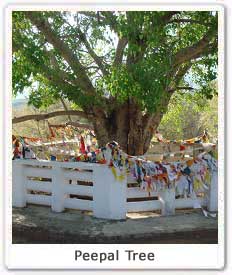| Kingdom : | Plantae |
| Division | Magnoliophyta |
| Class: | Magnoliopsida |
| Order : | Rosales |
| Family : | Moraceae |
| Genus : | Ficus |
| Species : | F. religiosa |
| Scientific Name : | Ficus religiosa |
| Found In : | Ranthambore Wildlife Sanctuary |
Other names : Bo tree, Bodhi tree, Sacred tree, Beepul tree, Pipers, Pimpal, Jari, Arani,Ashvattha, Ragi, Bodhidruma, Shuchidruma, Pipalla, Ashvattha and the Buddha tree are the other names used for the Banyan tree.
Description : Peepal is a large, fast growing deciduous tree. It has a heart shaped leaves. It is a medium size tree and has a large crown with the wonderful wide spreading branches. It shed its leaves in the month of March and April. The fruits of the Peepal are hidden with the figs. The figs are ripen in
 the
month of May. The figs which contain the flowers grow in pairs just below
the leaves and look like the berries. Its bark is light gray and peels in
patches. Its fruit is purple in colour. It is one of the longest living
trees.
the
month of May. The figs which contain the flowers grow in pairs just below
the leaves and look like the berries. Its bark is light gray and peels in
patches. Its fruit is purple in colour. It is one of the longest living
trees. Other Species : Artocarpus heterophyllus Lam, Artocarpus incissus L., Artocarpus nobilis Thw. Are some of the other species of the Peepal tree.
Location : Peepal tree is grown throughout India. It is mainly grown in State of Haryana, Bihar, Kerala and Madhya Pradesh. It is also found in the Ranthambore National Park in India.
Cultivation : Peepal tree is easily propagated through the seeds or through the cuttings. It can grow in any type of soil. Young peepal needs proper nourishment. It requires full sunlight and proper watering.
Medicinal uses : This tree of life has also got the medicinal value. The juice of its leaves extracted by holding them near the fire can be used as the ear drop. Its power bark has been used to heal the wounds for years. The bark of the tree is useful in inflammations and glandular swelling of the neck. Its root bark is useful for stomatitis, clean ulcers, and promotes granulations. Its roots are also good for gout. The roots are even chewed to prevent gum diseases. Its fruit is laxative which promotes digestion and checks vomiting. Its ripe fruits are good for the foul taste, thirst and heart diseases. The powered fruit is taken for Asthma. Its seeds have proved useful in urinary troubles. The leaves are used to treat constipation.
Other uses : People in India collect the Peepal leaves, clean them, dry them and than paint them with the gold acrylic in order to preserve them for years. From the bark of the Peepal tree reddish dye is extracted. Its leaves are used to feed the camels and the elephants. When the leaves are dried they are used for the decoration purpose.
Cultural importance : Peepal tree has the great importance in India especially among the Buddhist who regard Peepal tree as the personification of Buddha. Lord Buddha attained enlightenment mediating under the Peepal tree. It is regarded as the sacred tree and the people uses its leaves for the religious purposes. According to the Buddha – 'He who worships the Peepal tree will receive the same reward as if he worshiped me in person'. The Peepal tree has its own symbolic meaning of Enlightenment and peace. People tie threads of white, red and yellow silk around it to pray for progeny and rewarding parenthood. Hindus in India holds the great spiritual regard for the Peepal Tree, they regard it as the tree beneath which Vishnu was born.






